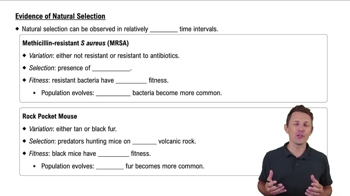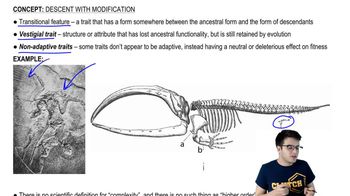Table of contents
- 1. Introduction to Biology2h 42m
- 2. Chemistry3h 40m
- 3. Water1h 26m
- 4. Biomolecules2h 23m
- 5. Cell Components2h 26m
- 6. The Membrane2h 31m
- 7. Energy and Metabolism2h 0m
- 8. Respiration2h 40m
- 9. Photosynthesis2h 49m
- 10. Cell Signaling59m
- 11. Cell Division2h 47m
- 12. Meiosis2h 0m
- 13. Mendelian Genetics4h 44m
- Introduction to Mendel's Experiments7m
- Genotype vs. Phenotype17m
- Punnett Squares13m
- Mendel's Experiments26m
- Mendel's Laws18m
- Monohybrid Crosses19m
- Test Crosses14m
- Dihybrid Crosses20m
- Punnett Square Probability26m
- Incomplete Dominance vs. Codominance20m
- Epistasis7m
- Non-Mendelian Genetics12m
- Pedigrees6m
- Autosomal Inheritance21m
- Sex-Linked Inheritance43m
- X-Inactivation9m
- 14. DNA Synthesis2h 27m
- 15. Gene Expression3h 20m
- 16. Regulation of Expression3h 31m
- Introduction to Regulation of Gene Expression13m
- Prokaryotic Gene Regulation via Operons27m
- The Lac Operon21m
- Glucose's Impact on Lac Operon25m
- The Trp Operon20m
- Review of the Lac Operon & Trp Operon11m
- Introduction to Eukaryotic Gene Regulation9m
- Eukaryotic Chromatin Modifications16m
- Eukaryotic Transcriptional Control22m
- Eukaryotic Post-Transcriptional Regulation28m
- Eukaryotic Post-Translational Regulation13m
- 17. Viruses37m
- 18. Biotechnology2h 58m
- 19. Genomics17m
- 20. Development1h 5m
- 21. Evolution3h 1m
- 22. Evolution of Populations3h 52m
- 23. Speciation1h 37m
- 24. History of Life on Earth2h 6m
- 25. Phylogeny2h 31m
- 26. Prokaryotes4h 59m
- 27. Protists1h 12m
- 28. Plants1h 22m
- 29. Fungi36m
- 30. Overview of Animals34m
- 31. Invertebrates1h 2m
- 32. Vertebrates50m
- 33. Plant Anatomy1h 3m
- 34. Vascular Plant Transport1h 2m
- 35. Soil37m
- 36. Plant Reproduction47m
- 37. Plant Sensation and Response1h 9m
- 38. Animal Form and Function1h 19m
- 39. Digestive System1h 10m
- 40. Circulatory System1h 57m
- 41. Immune System1h 12m
- 42. Osmoregulation and Excretion50m
- 43. Endocrine System1h 4m
- 44. Animal Reproduction1h 2m
- 45. Nervous System1h 55m
- 46. Sensory Systems46m
- 47. Muscle Systems23m
- 48. Ecology3h 11m
- Introduction to Ecology20m
- Biogeography14m
- Earth's Climate Patterns50m
- Introduction to Terrestrial Biomes10m
- Terrestrial Biomes: Near Equator13m
- Terrestrial Biomes: Temperate Regions10m
- Terrestrial Biomes: Northern Regions15m
- Introduction to Aquatic Biomes27m
- Freshwater Aquatic Biomes14m
- Marine Aquatic Biomes13m
- 49. Animal Behavior28m
- 50. Population Ecology3h 41m
- Introduction to Population Ecology28m
- Population Sampling Methods23m
- Life History12m
- Population Demography17m
- Factors Limiting Population Growth14m
- Introduction to Population Growth Models22m
- Linear Population Growth6m
- Exponential Population Growth29m
- Logistic Population Growth32m
- r/K Selection10m
- The Human Population22m
- 51. Community Ecology2h 46m
- Introduction to Community Ecology2m
- Introduction to Community Interactions9m
- Community Interactions: Competition (-/-)38m
- Community Interactions: Exploitation (+/-)23m
- Community Interactions: Mutualism (+/+) & Commensalism (+/0)9m
- Community Structure35m
- Community Dynamics26m
- Geographic Impact on Communities21m
- 52. Ecosystems2h 36m
- 53. Conservation Biology24m
21. Evolution
Introduction to Evolution and Natural Selection
Problem 3`
Textbook Question
Within six months of effectively using methicillin to treat S. aureus infections in a community, all new S. aureus infections were caused by MRSA. How can this best be explained?
a. A patient must have become infected with MRSA from another community.
b. In response to the drug, S. aureus began making drug- resistant versions of the protein targeted by the drug.
c. Some drug-resistant bacteria were present at the start of treatment, and natural selection increased their frequency.
d. S. aureus evolved to resist vaccines.
 Verified step by step guidance
Verified step by step guidance1
Understand the concept of natural selection: Natural selection is a process where organisms better adapted to their environment tend to survive and produce more offspring. In the context of antibiotic resistance, bacteria that have mutations allowing them to survive the presence of an antibiotic will reproduce more successfully than those that do not.
Consider the role of pre-existing genetic variation: Before the introduction of methicillin, there may have been a small number of S. aureus bacteria with mutations that conferred resistance to methicillin. These bacteria would have had a survival advantage once methicillin was used.
Analyze the impact of antibiotic use: When methicillin is used to treat infections, it kills susceptible bacteria, but resistant bacteria survive and continue to reproduce. Over time, the proportion of resistant bacteria increases in the population.
Evaluate the options given: Option c suggests that some drug-resistant bacteria were present at the start of treatment, and natural selection increased their frequency. This aligns with the concept of natural selection and the impact of antibiotic use.
Conclude with the most plausible explanation: Based on the understanding of natural selection and antibiotic resistance, option c is the best explanation for the emergence of MRSA in the community after methicillin use.
 Verified video answer for a similar problem:
Verified video answer for a similar problem:This video solution was recommended by our tutors as helpful for the problem above
Video duration:
1mPlay a video:
Was this helpful?
Key Concepts
Here are the essential concepts you must grasp in order to answer the question correctly.
Antibiotic Resistance
Antibiotic resistance occurs when bacteria evolve mechanisms to withstand the effects of drugs designed to kill them. This can happen through genetic mutations or acquiring resistance genes from other bacteria. Overuse or misuse of antibiotics accelerates this process, leading to strains like MRSA that are resistant to multiple drugs.
Recommended video:

Evidence of Natural Selection
Natural Selection
Natural selection is a process where organisms better adapted to their environment tend to survive and reproduce more than others. In the context of antibiotic resistance, bacteria with mutations that confer drug resistance survive antibiotic treatment, while susceptible ones die off, increasing the frequency of resistant strains in the population.
Recommended video:

Natural Selection
Genetic Variation in Bacteria
Genetic variation in bacteria is crucial for evolution and adaptation. Bacteria can acquire genetic changes through mutations or horizontal gene transfer, which can lead to traits like antibiotic resistance. This variation allows some bacteria to survive antibiotic treatment, leading to the emergence of resistant populations like MRSA.
Recommended video:

Sources of Genetic Variation

 4:58m
4:58mWatch next
Master Evolution and Natural Selection with a bite sized video explanation from Jason
Start learningRelated Videos
Related Practice
































